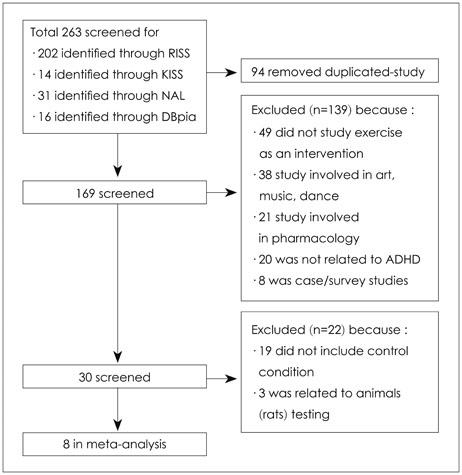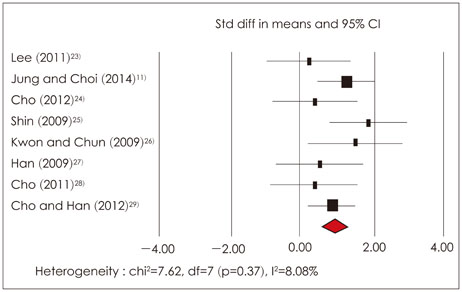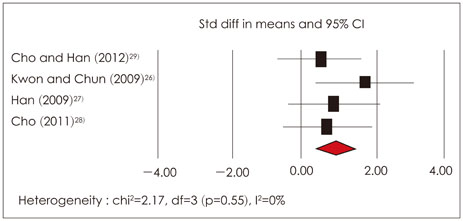J Korean Neuropsychiatr Assoc.
2015 Nov;54(4):399-405. 10.4306/jknpa.2015.54.4.399.
Exercise Effect in Children with Attention-Deficit Hyperactivity Disorder : Meta-Analysis of Domestic Study
- Affiliations
-
- 1Department of Industry Academic Cooperation, Chung-Ang University, Seoul, Korea.
- 2Department of Psychiatry, Chung-Ang University Hospital, Seoul, Korea. hduk70@gmail.com
- KMID: 2149321
- DOI: http://doi.org/10.4306/jknpa.2015.54.4.399
Abstract
- The aim of this meta-analysis study was to examine the effectiveness of exercise interventions on attention-deficit hyperactivity disorder (ADHD) pertaining to cognitive function such as attention and impulsivity in children.ZA comprehensive literature search was conducted using databases including Korean Information Service System, DBpia, Research Information Sharing Service, and National Assembly Library from 1995 to 2014. Search terms included 'ADHD', 'children', 'exercise', 'physical activity', and 'sports'. Standardized mean difference and 95% confidence intervals were calculated, and the heterogeneity of the studies was estimated using Q statistic. That is, these results revealed that effectiveness of exercise groups was higher by approximately 32% compared with control groups.ZEight studies (n=150) satisfied the inclusion criteria. The meta-analysis suggested that exercise has a moderate to large effect on core symptoms involved in attention [effect size (ES)=0.93] and impulsivity (ES=0.92) in children with ADHD. The main findings indicate that exercise, based on several types of exercise intervention, appears to be effective for mitigating symptoms such as attention, impulsivity in children with ADHD. From this perspective, exercise might be an effective adjunctive therapy for enhancing the effects of medication in children with ADHD. Future study related to exercise effect on ADHD symptoms is required in order to understand the specific evidence of relationship between exercise and core symptoms.
Keyword
MeSH Terms
Figure
Reference
-
1. Polanczyk G, de Lima MS, Horta BL, Biederman J, Rohde LA. The worldwide prevalence of ADHD: a systematic review and metaregression analysis. Am J Psychiatry. 2007; 164:942–948.
Article2. American Psychiatric Association. Diagnostic and Statistical Manual of Mental Disorders: DSM-IV-TR. 4th ed. Washington, DC: American Psychiatric Association;2000.3. Health insurance review & assessment service [hompage the Internet]. updated 2012 May 12. cited 2015 Jul 21. Available from: http://www.hira.or.kr/dummy.do?pgmid=HIRAA020041000000&cmsurl=/cms/notice/02/1211821_24959.html&subject.4. Biederman J, Monuteaux MC, Doyle AE, Seidman LJ, Wilens TE, Ferrero F, et al. Impact of executive function deficits and attentiondeficit/ hyperactivity disorder (ADHD) on academic outcomes in children. J Consult Clin Psychol. 2004; 72:757–766.
Article5. Wolraich ML, Wibbelsman CJ, Brown TE, Evans SW, Gotlieb EM, Knight JR, et al. Attention-deficit/hyperactivity disorder among adolescents: a review of the diagnosis, treatment, and clinical implications. Pediatrics. 2005; 115:1734–1746.
Article6. Biederman J, Faraone SV. Attention-deficit hyperactivity disorder. Lancet. 2005; 366:237–248.
Article7. Klein RG, Mannuzza S. 30-year prospective longitudinal study of ADHD. Eur J Psychiatry. 2008; 23:S382.
Article8. Goldman LS, Genel M, Bezman RJ, Slanetz PJ. Diagnosis and treatment of attention-deficit/hyperactivity disorder in children and adolescents. Council on scientific affairs, American medical association. JAMA. 1998; 279:1100–1107.
Article9. Spencer T, Biederman J, Wilens T, Harding M, O'Donnell D, Griffin S. Pharmacotherapy of attention-deficit hyperactivity disorder across the life cycle. J Am Acad Child Adolesc Psychiatry. 1996; 35:409–432.
Article10. Graham J, Banaschewski T, Buitelaar J, Coghill D, Danckaerts M, Dittmann RW, et al. European guidelines on managing adverse effects of medication for ADHD. Eur Child Adolesc Psychiatry. 2011; 20:17–37.
Article11. Jung HY, Choi JW. The effects of aerobic exercise on executive function and EEG in children with attention deficit hyperactivity disorder. Korean J Sport Psychol. 2014; 25:13–28.12. Song HJ, Choi EY, Hong YK, Yang IM. Effect of ADHD childrens motor coordination on mental health. J Spec Educ Rehabil Sci. 2010; 49:241–264.13. Choi JW, Han DH, Jung HY, Kang KD. The effect participation in regular exercise on health-related fitness and creativity in children with ADHD. J Korean Phys Edu Assoc Girls Women. 2012; 26:127–143.14. Kang KD, Choi JW, Kang SG, Han DH. Sports therapy for attention, cognitions and sociality. Int J Sports Med. 2011; 32:953–959.
Article15. Pontifex MB, Saliba BJ, Raine LB, Picchietti DL, Hillman CH. Exercise improves behavioral, neurocognitive, and scholastic performance in children with attention-deficit/hyperactivity disorder. J Pediatr. 2013; 162:543–551.
Article16. Choi JW, Han DH, Kang KD, Jung HY, Renshaw PF. Aerobic exercise and attention deficit hyperactivity disorder: brain research. Med Sci Sports Exerc. 2015; 47:33–39.17. Wigal SB, Emmerson N, Gehricke JG, Galassetti P. Exercise: applications to childhood ADHD. J Atten Disord. 2013; 17:279–290.18. Tomporowski PD, Davis CL, Miller PH, Naglieri JA. Exercise and childrens intelligence, cognition, and academic achievement. Educ Psychol Rev. 2008; 20:111–131.
Article19. Hillman CH, Erickson KI, Kramer AF. Be smart, exercise your heart: exercise effects on brain and cognition. Nat Rev Neurosci. 2008; 9:58–65.
Article20. Oh SS. Meta-analysis: Theory and practice. Seoul: Konkuk University Press;2002.21. Park EY, Shin IS. The effects of transitional education programs on adaptive behavior in students with developmental disabilities: a meta-analysis. Disabil Employ. 2011; 21:59–78.
Article22. Borenstein M, Hedges LV, Higgins JPT, Rothstein HR. Introduction to Meta-Analysis. Chichester: Wiley;2009.23. Lee SK. The effects of combined exercise on physical fitness, neurotransmitter, EEG and frontal lobe executive function in children with attention deficit hyperactivity disorder(ADHD) [dissertation]. Seoul: Sookmyung Women's University;2011.24. Cho JH. The effect of exercise type on children's attention behavior with attention deficit hyperactivity disorder. J Coaching Dev. 2012; 14:42–52.25. Shin JH. The effect of ball game program on the improvement of ADHD children's attention [dissertation]. Osan: Hanshin University;2009.26. Kwon SH, Chun JH. The effects of new-sports program on adjustment behaviors improvement of children with ADHD. Korean J Learn Disabil. 2009; 6:153–171.27. Han CK. The effect of body balance for the attention behavior of ADHD with children [dissertation]. Osan: Hanshin University;2009.28. Cho JH. Effect of combined exercise for 12 weeks on children's attention behavior with attention deficit hyperactivity disorder. J Korean Soc Living Environ Syst. 2011; 18:690–698.29. Cho SB, Han CK. Effect of jump exercise program on attention, recognition strength and work load of ADHD children. Korean J Sports Sci. 2012; 21:1369–1377.30. Cohen J. Statistical power analysis for the behavioral sciences. 2nd ed. Hillsdale, NJ: L. Erlbaum Associates;1988.31. Cerrillo-Urbina AJ, García-Hermoso A, Sánchez-López M, Pardo-Guijarro MJ, Santos Gómez JL, Martínez-Vizcaíno V. The effects of physical exercise in children with attention deficit hyperactivity disorder: a systematic review and meta-analysis of randomized control trials. Child Care Health Dev. 2015; May. 18. [Epub]. DOI: 10.1111/cch.12255.
Article32. Neudecker C, Mewes N, Reimers AK, Woll A. Exercise interventions in children and adolescents with ADHD: a systematic review. J Atten Disord. 2015; May. 11. [Epub]. DOI: 10.1177/1087054715584053.
Article33. Mun JH. The effects of aerobic exercise program on attention and basic academic skills of students with learning disabilities [dissertation]. Deagu: Deagu University;2014.34. Bluechardt MH, Wiener J, Shephard RJ. Exercise programmes in the treatment of children with learning disabilities. Sports Med. 1995; 19:55–72.
Article35. Sibley BA, Etnier JL. The relationship between physical activity and cognition in children: a meta-analysis. Pediatr Exerc Sci. 2003; 15:243–256.
Article36. Scarmeas N, Stern Y. Cognitive reserve: implications for diagnosis and prevention of Alzheimer's disease. Curr Neurol Neurosci Rep. 2004; 4:374–380.
Article37. Scarmeas N, Zarahn E, Anderson KE, Habeck CG, Hilton J, Flynn J, et al. Association of life activities with cerebral blood flow in Alzheimer disease: implications for the cognitive reserve hypothesis. Arch Neurol. 2003; 60:359–365.
Article38. van Uffelen JG, Chin A Paw MJ, Hopman-Rock M, van Mechelen W. The effects of exercise on cognition in older adults with and without cognitive decline: a systematic review. Clin J Sport Med. 2008; 18:486–500.
Article39. Yerkes RM, Dodson JD. The relation of strength of stimulus to rapidity of habit-formation. J Comp Neurology Psychol. 1908; 18:459–482.
Article40. Kahneman D. Attention and effort. Englewood Cliffs, NJ: Prentice-Hall;1973.41. Nemet D, Oh Y, Kim HS, Hill M, Cooper DM. Effect of intense exercise on inflammatory cytokines and growth mediators in adolescent boys. Pediatrics. 2002; 110:681–689.
Article42. Lambourne K, Tomporowski P. The effect of exercise-induced arousal on cognitive task performance: a meta-regression analysis. Brain Res. 2010; 1341:12–24.
Article43. Rethorst CD, Wipfli BM, Landers DM. The antidepressive effects of exercise: a meta-analysis of randomized trials. Sports Med. 2009; 39:491–511.44. Zouhal H, Jacob C, Delamarche P, Gratas-Delamarche A. Catecholamines and the effects of exercise, training and gender. Sports Med. 2008; 38:401–423.
Article45. Hillman CH, Snook EM, Jerome GJ. Acute cardiovascular exercise and executive control function. Int J Psychophysiol. 2003; 48:307–314.
Article46. Cotman CW, Berchtold NC, Christie LA. Exercise builds brain health: key roles of growth factor cascades and inflammation. Trends Neurosci. 2007; 30:464–472.
Article47. Spalletta G, Pasini A, Pau F, Guido G, Menghini L, Caltagirone C. Prefrontal blood flow dysregulation in drug naive ADHD children without structural abnormalities. J Neural Transm. 2001; 108:1203–1216.
Article48. Blomstrand E, Perrett D, Parry-Billings M, Newsholme EA. Effect of sustained exercise on plasma amino acid concentrations and on 5-hydroxytryptamine metabolism in six different brain regions in the rat. Acta Physiol Scand. 1989; 136:473–481.
Article49. Ratey JJ, Hagerman E. Spark: the revolutionary new science of exercise and the brain. New York: Little Brown & Company;2008.
- Full Text Links
- Actions
-
Cited
- CITED
-
- Close
- Share
- Similar articles
-
- Meta Analysis of Variables Related to Attention Deficit Hyperactivity Disorder in School-Age Children
- Non-Stimulant Medications in the Treatment of Attention-Deficit Hyperactivity Disorder
- Diagnosis and Comorbidity of Attention Deficit Hyperactivity Disorder in School-Aged Children
- Diagnosis and Management of Attention Deficit Hyperactivity Disorder
- The Effect of Attention Level of Attention Deficit Hyperactivity Disorder on CPT and WCST




